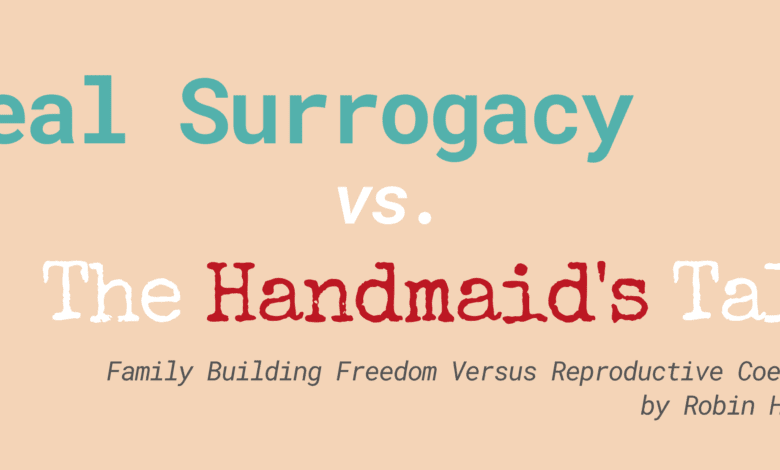Real Surrogacy vs. The Handmaid’s Tale

In traditional surrogacy, a surrogate – commonly called a “surrogate mother” – is artificially inseminated with the sperm of the intended father or another sperm donor to fertilize her own eggs. A traditional surrogate agrees to terminate her parental rights, and the baby becomes legally the child of the intended parents. This type of surrogacy is not commonly practiced today because of the potential emotional and legal complications that can arise (as illustrated in episode 2 of the show where this emotional attachment destroys Handmaid Janine). It seems obvious, right? Today, most surrogacy professionals advocate for gestational surrogacy. In gestational surrogacy, a surrogate, or “gestational carrier,” agrees to undergo in vitro fertilization so that doctors can implant one (or sometimes two) embryos into her uterus. IVF doctors create these embryos using healthy eggs and sperm, which may or may not be genetically connected to the intended parents, depending on their reproductive characteristics, fertility, or even personal preferences. #transrightsarehumanrights
Myth #2: Surrogates Have to Leave Their Homes to Live with the Intended Parents or Give Birth Where the Intended Parents Decide
In The Handmaid’s Tale, slaves were forced to live with their oppressors or faced physical punishment, torture, or even death if they did not comply. Perhaps from the show, the aides are forced to give births at home, without medical assistance, in the room from their Commander’s wife, as shown in episode 2, season 1.
Surrogates in the US are not forced away from their own families and children for a surrogacy journey. Since the best predictor of a successful pregnancy is a previous pregnancy, a surrogate must have already had at least one child, so she knows she is healthy enough to provide a child for a future parent who needs her help. Alternates must supported and surrounded by their closest friends and family in this wonderful process. Surrogates, along with their intended parents, choose their own preferred nearby hospital (usually with a Level II or Level III NICU if needed) to give birth. Maybe they even delivered there before with their own children. If a surrogate is carrying twins, they can also see a maternal fetal specialist for several appointments for extra, additional care. As long as a surrogate’s OBGYN welcomes and supports biological parents – regardless of their age, gender identity, race, and sexual orientation – OBGYN appointments for the parent(s) and surrogate may be an incredible way to get along on the trip! Intended parents have some decision-making power when it comes to medical decisions about their baby during birth, but all of these arrangements are carefully discussed beforehand.
Myth #3: Substitutes Have No Choice
The Maid Story has raised an intense conversation about reproductive ethics. Rising extremist leaders are forcing fertile women into the role of “slave girls” for the purpose of bearing children for male “commanders” and their husbands. (Content warning #2: Anyone who disagrees and is a member of the LGBTQIA+ community is publicly killed on the show.) Once slaves give birth to their biological child, they must hand the baby over to their “owners” without parental rights, and having to breastfeed and care for a baby in the same home as their oppressors. The maids are sent like cattle to another home to repeat the whole abuse. (In real life, surrogates don’t usually breastfeed the baby. In fact, an intended parent can successfully induce breastfeeding themselves so that they experience an amazing bonding moment. and again, the This future society doesn’t really believe in medicine, let alone reproductive science!)
We’ve said it before, and we’ll say it again: Surrogacy through a reputable and regulated agency is 100% voluntary in the United States. Ignorant celebrities (like Gloria Steinem) lack the necessary knowledge to make claims, no basisif not. As a society, we need to learn to trust women and those who are capable of bearing children to make their own empowered and informed life decisions. That trust includes whether a person agrees to help another person build their family or not. Women who choose to carry a child that is not theirs are some of the most intelligent, passionate, and selfless women to walk this planet. I have personally met at least several hundred potential surrogates through Creative Family Connections’ in-house interview process. These visits, in person before COVID and by Zoom during COVID, opened a window into the home and world lives of these women, and were some of the most inspiring moments I will always remember. There’s no need to shy away from the fact that financial benefits help surrogates and their child(ren) by eliminating debt, or starting a college fund, or putting a down payment on a new home. These benefits are eligible, but never absolutely necessary – In fact, women who receive government assistance (food stamps and Medicaid insurance, for example) cannot be surrogates under our surrogacy qualifications. and many other leading surrogacy agencies. The American Society of Reproductive Medicine (ASRM) guidelines. don’t touch on the fact that a candidate should be rejected if there is “evidence of financial or emotional duress” involved. Surrogate women decide to become pregnant again because they want others to experience the indescribable joy they experienced with their own children. If someone is willing and able to make the decision to be an alternate, then more power to them for wanting to make the world a better place.
Comment or question for the writer?
Robin Hinson can be reached at robin@creativefamilyconnections.com.





